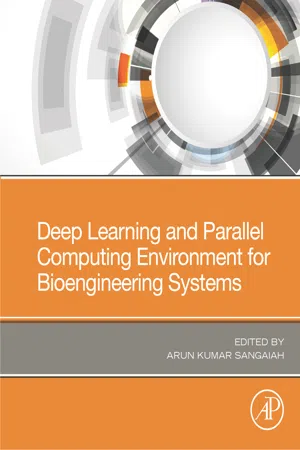
Deep Learning and Parallel Computing Environment for Bioengineering Systems
- 280 pages
- English
- ePUB (mobile friendly)
- Available on iOS & Android
Deep Learning and Parallel Computing Environment for Bioengineering Systems
About this book
Deep Learning and Parallel Computing Environment for Bioengineering Systems delivers a significant forum for the technical advancement of deep learning in parallel computing environment across bio-engineering diversified domains and its applications. Pursuing an interdisciplinary approach, it focuses on methods used to identify and acquire valid, potentially useful knowledge sources. Managing the gathered knowledge and applying it to multiple domains including health care, social networks, mining, recommendation systems, image processing, pattern recognition and predictions using deep learning paradigms is the major strength of this book. This book integrates the core ideas of deep learning and its applications in bio engineering application domains, to be accessible to all scholars and academicians. The proposed techniques and concepts in this book can be extended in future to accommodate changing business organizations' needs as well as practitioners' innovative ideas.- Presents novel, in-depth research contributions from a methodological/application perspective in understanding the fusion of deep machine learning paradigms and their capabilities in solving a diverse range of problems- Illustrates the state-of-the-art and recent developments in the new theories and applications of deep learning approaches applied to parallel computing environment in bioengineering systems- Provides concepts and technologies that are successfully used in the implementation of today's intelligent data-centric critical systems and multi-media Cloud-Big data
Frequently asked questions
- Essential is ideal for learners and professionals who enjoy exploring a wide range of subjects. Access the Essential Library with 800,000+ trusted titles and best-sellers across business, personal growth, and the humanities. Includes unlimited reading time and Standard Read Aloud voice.
- Complete: Perfect for advanced learners and researchers needing full, unrestricted access. Unlock 1.4M+ books across hundreds of subjects, including academic and specialized titles. The Complete Plan also includes advanced features like Premium Read Aloud and Research Assistant.
Please note we cannot support devices running on iOS 13 and Android 7 or earlier. Learn more about using the app.
Information
Parallel Computing, Graphics Processing Unit (GPU) and New Hardware for Deep Learning in Computational Intelligence Research
Abstract
Keywords
1.1 Introduction
1.1.1 Machine and Deep Learning
1.1.2 Graphics Processing Unit (GPU)
1.1.3 Computational Intelligence
1.1.4 GPU, Deep Learning and Computational Intelligence
Table of contents
- Cover image
- Title page
- Table of Contents
- Copyright
- Preface
- Foreword
- Acknowledgment
- Chapter 1: Parallel Computing, Graphics Processing Unit (GPU) and New Hardware for Deep Learning in Computational Intelligence Research
- Chapter 2: Big Data Analytics and Deep Learning in Bioinformatics With Hadoop
- Chapter 3: Image Fusion Through Deep Convolutional Neural Network
- Chapter 4: Medical Imaging With Intelligent Systems: A Review
- Chapter 5: Medical Image Analysis With Deep Neural Networks
- Chapter 6: Deep Convolutional Neural Network for Image Classification on CUDA Platform
- Chapter 7: Efficient Deep Learning Approaches for Health Informatics
- Chapter 8: Deep Learning and Semi-Supervised and Transfer Learning Algorithms for Medical Imaging
- Chapter 9: Survey on Evaluating the Performance of Machine Learning Algorithms: Past Contributions and Future Roadmap
- Chapter 10: Miracle of Deep Learning Using IoT
- Chapter 11: Challenges in Storing and Processing Big Data Using Hadoop and Spark
- Chapter 12: An Efficient Biography-Based Optimization Algorithm to Solve the Location Routing Problem With Intermediate Depots for Multiple Perishable Products
- Chapter 13: Evolutionary Mapping Techniques for Systolic Computing System
- Chapter 14: Varied Expression Analysis of Children With ASD Using Multimodal Deep Learning Technique
- Chapter 15: Parallel Machine Learning and Deep Learning Approaches for Bioinformatics
- Index